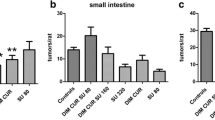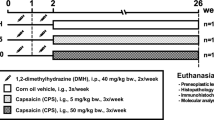Abstract
The ability of 5-aminosalicylic acid and olsalazine to inhibit colonic aberrant crypts and tumors was investigated in 1,2-dimethylhydrazine-treated rats. The effect of these drugs on the rates of tumor apoptosis and proliferation was studied as potential mechanisms for their action. 5-Aminosalicylic acid reduced the number of aberrant crypt foci by over one third, while olsalazine had no effect on this parameter. However, both agents effectively reduced tumor number and load, increased the rate of tumor apoptosis, and reduced the rate of tumor cell proliferation. In conclusion, 5-aminosalicylic acid and olsalazine are both ultimately effective chemopreventive agents in this model; however, only 5-aminosalicylic acid inhibited the formation of aberrant crypt foci. The inhibitory effect of these agents in tumors is related to the inhibition of proliferation and the induction of apoptosis.
Similar content being viewed by others
REFERENCES
Skinner SA, Penney AG, O'Brien PE: Sulindac inhibits the rate of growth and appearance of colon tumors in the rat. Arch Surg 126:1094–1096, 1991
Charalambous D, O'Brien PE: Inhibition of colon cancer precursors in the rat by sulindac sulphone is not dependent on inhibition of prostaglandin synthesis. J Gastroenterol Hepatol 11:307–310, 1996
Charalambous D, Farmer KCR, O'Brien PE: Sulindac and indomethacin inhibit formation of aberant crypt foci in the colons of dimethyl hydrazine treated rats. J Gastroenterol Hepatol 11:88–92, 1996
Kune GA, Kune S, Watson LF: Colorectal cancer risk, chronic illnesses, operations and medications: Case control results from the Melbourne colorectal cancer study. Cancer Res 48:4399–4404, 1988
Nugent KP, Farmer KCR, Spigelman AD, Williams CB, Phillips RKS: Randomized controlled trial of the effect of sulindac on duodenal and rectal polyposis and cell proliferation in patients with familial adenomatous polyposis. Br J Surg 80:1618–1619, 1993
Labayle D, Fischer D, Veilh P, Drouhin F, Pariente A, Bories C, Duhamel O, Trousset M, Attali P: Sulindac causes regression of rectal polyps in familial adenomatous polyposis. Gastroenterology 101:635–639, 1991
Gabriel SE, Jaakkimainen L, Bombardier C: Risk for serious gastrointestinal complications related to use of nonsteroidal anti-inflammatory drugs. Ann Intern Med 115:787–796, 1991
Piazza GA, Alberts DS, Hixson LJ, Paranka NS, Li H, Finn T, Bogert C, Guillen JM, Brendel K, Gross PH, Sperl G, Ritchie J, Burt RW, Ellsworth L, Ahnen DJ, Pamukcu R: Sulindac sulfone inhibits azoxymethane-induced colon carcinogenesis in rats without reducing prostaglandin levels. Cancer Res 57:2909–2915, 1997
Charalambous D, Skinner S, O'Brien P: Sulindac inhibits colorectal tumor growth, but not prostaglandin synthesis in the rat. J Gastroenterol Hepatol 13:1195–1200, 1998
Chiu C-H, McEntee M, Whelan J: Sulindac causes rapid regression of preexisting tumors in Min/+ mice independent of prostaglandin biosynthesis. Cancer Res 57:4267–4273, 1997
Staerk Laursen L, Stokholm M, Bukhave K, Rask-Masden J, Lauritsen K: Disposition of 5–aminosalicylic acid by olsalazine and three mesalazine preparations in patients with ulcerative colitis: Comparison of intraluminal colonic concentrations, serum values and urinary excretion. Gut 31:1271–1276, 1990
Ryde M, Huitfeldt B, Pettersson R: Relative bioavailability of olsalazine from tablets and capsules: A drug targeted for local effect in the colon. Biopharm Drug Dispos 12:233–246, 1991
Horn H, Preclik G, Stange EF, Ditschuneit H: Modulation of arachidonic acid metaboism by olsalazine and other aminosalicylates in leukocytes. Scand J Gastroenterol 26:867–879, 1991
Rampton D, McNeil N, Sarner M: Anaglesic ingestion and other factors preceding relapse in ulcerative colitis. Gut 24:187–189, 1983
Gionchetti P, Guarnieri C, Campieri M, Belluzzi A, Brignola C, Oannone P, Miglioli M, Barbara L: Scavenger effect of sulfasalazine, 5–aminosalicylic acid and olsalazine on superoxide radical generation. Dig Dis Sci 36:174–178, 1991
Nielsen O, Buhave K, Elmgreen J, Ahnfelt-Ronne I: Inhibition of 5–lipoxygenase pathway of arachidonic acid metabolism in human neutrophils by sulfasalazine and 5–aminosalicylic acid. Dig Dis Sci 32:577–582, 1987
Hawkey C, Boughton-Smith N, Whittle B: Modulation of human colonic arachidonic acid metabolism by sulfasalazine. Dig Dis Sci 30:1161–1165, 1985
Molin L, Stendahl O: The effect of sulfasalazine and its active components on human polymorphonuclear leukocyte function in relation to ulcerative colitis. Acta Med Scand 206:451–457, 1979
Moghadasian MH, Freeman HJ, Godin DV: Endogenous antioxidant status in neoplastic and adjacent tissues in 1,2–dimethylhydrazine-induced colon cancer in rats: effects of olsalazine. Carcinogenesis 17(5):983–987, 1996
Ikawa H, Kamitani H, Calvo B, Foley J, Eling T: Expression of 15–lipoxygenase-1 in human colorectal cancer. Cancer Res 59:360–366, 1999
Wadworth AN, Fitton A: Osalazine: A review of its pharmacodynamics and pharmacokinetic properties. Drugs 41(4):647–664, 1991
Pretlow TP, Barrow BJ, Ashton WS, O'Riordan MA, Pretlow TG, Jurcisek JA, Stellato TA: Aberrant crypts: Putative preneoplastic foci in human colonic mucosa. Cancer Res 51:1564–1567, 1991
Samaha HS, Hamid R, El-Bayoumy K, Rao CV, Reddy BS: The role of apoptosis in the modulation of colon carcinogenesis by dietary fat and by the organoselenium compound 1,4–Phenylenebis(methylene)selenocyanate. Can Epidemiol Biomark Prevent 6:699–704, 1997
Hall PA, Coates PJ, Ansari B, Hopwood D: Regulation of cell number in the mammalian gastrointestinal tract: the importance of apoptosis. J Cell Sci 107:3569–3577, 1994
Samaha SS, Kelloff GJ, Steele V, Rao CV, Reddy BS: Modulation of apoptosis by sulindac, curcumin, phenylethyl-3–methylcaffeate, and 6–phenylhexyl isothiocyanate: Apoptotic index as a biomarker in colon cancer chemoprevention and promotion. Cancer Res 57:1301–1305, 1997
Brown W, Skinner S, Vogiagis D, Malcontenti-Wilson C, De-Jong T, Van Driel I, Farmer K, O'Brien P: Chemoprevention of colorectal cancer-the mechanism is multifactorial. Gastroenterology 114:A571, 1998
Brown W, Skinner S, Vogiagis D, O'Brien P: Chemoprevention of colorectal cancer-a comparative study of efficacy and gastrotoxicity of NSAIDs. J Gastroenterol Hepatol 13:A128, 1998
McLennan EA, Bird RP: Specificity study to evaluate induction of aberrant crypts in murine colons. Cancer Res 6183–6186, 1988
Reddy BS, Rao CV, Seibert K: Evaluation of cyclooxygenase-2 inhibitor for potential chemopreventive properties in colon carcinogenesis. Cancer Res 56:4566–4569, 1996
Kawamori T, Rao CV, Seibert K, Reddy BS: Chemopreventive activity of celecoxib, a specific cyclooxygenase-2 inhibitor, against colon carcinogenesis. Cancer Res 58:409–412, 1998
Baeg GH, Matsumine A, Kuroda T, Bhattacharjee RN, Miyashiro I, Toyoshima K, Akiyama T: The tumor suppressor gene product APC blocks cell cycle progression from Go/G1 to S phase. EMBO J 14:5618–5625, 1995
Samarut J: The colorectal tumor suppressor APC and its partners. Jpn J Cancer Res 88:cover, 1997
Markowitz S, Wang J, Myeroff L, Parsons R, Sun L, Lutterbaugh J, Fan R, Zborowska E, Kinzler K, Vogelstein B, Brattain M, Willson J: Inactivation of the type II TGFbreceptor in colon cancer cells with microsatellite instability. Science 268:1336–1338, 1995
Sheng H, Shao J, Hooton EB, Tsujii M, DuBois RN, Beauchamp RD: Cyclooxygenase-2 induction and transforming growth factor B growth inhibition in rat intestinal epithelial cells. Cell Grow Diff 8:463–470, 1997
Jayadev S, Liu B, Bielawska A, Joanna Y, Fausta N, Marina Y: Role for ceramide in cell cycle arrest. JBC 270:2047–2052, 1995
Zhang J, Alter N, Reed J, Borner C, Obeid L, Hannun Y: Bcl-2 interrupts the ceramide-mediated pathway of cell death. Proc Natl Acad Sci USA 93:5325–5328, 1996
Maltzman T, Whittington J, Driggers L, Stephens J, Ahnen D: AOM-induced mouse colon tumors do not express full-length APC protein. Carcinogenesis 18:2435–2439, 1997
Takahashi M, Fukuda K, Sugimura T, Wakabayashi K: B-Catenin is frequently mutated and demonstrates altered cellular location in azoxymethane-induced rat colon tumors. Cancer Res 58:42–46, 1998
Chan TA, Morin PJ, Vogelstein B, Kinzler KW: Mechanisms underlying nonsteroidal antiinflammatory drug mediated apoptosis. Proc Natl Acad Sci USA 95:681–686, 1998
Jacobs MM: Selenium inhibition of 1,2–dimethylhydrazineinduced colon carcinogenesis. Cancer Res 43:1646–1649, 1983
Author information
Authors and Affiliations
Rights and permissions
About this article
Cite this article
Brown, W.A., Farmer, K.C., Skinner, S.A. et al. 5-Aminosalicylic Acid and Olsalazine Inhibit Tumor Growth in a Rodent Model of Colorectal Cancer. Dig Dis Sci 45, 1578–1584 (2000). https://doi.org/10.1023/A:1005517112039
Issue Date:
DOI: https://doi.org/10.1023/A:1005517112039




